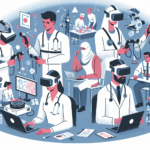-
Table of Contents
“Transforming Talent: The Digital Revolution in Human Resources”
Introduction

The rapid advancement of technology has profoundly transformed various sectors, and human resources (HR) is no exception. The integration of sophisticated technologies such as artificial intelligence (AI), machine learning, big data analytics, and cloud computing has revolutionized traditional HR practices, leading to more efficient, data-driven, and strategic operations. These technological innovations have streamlined recruitment processes, enhanced employee engagement, and facilitated more effective talent management. Additionally, technology has enabled remote work and flexible working arrangements, reshaping workplace dynamics and organizational culture. As HR continues to evolve in response to technological advancements, it is crucial to understand the multifaceted impact of these changes on workforce management, employee experience, and overall organizational performance.
Enhancing Recruitment Processes Through AI and Automation
The rapid advancement of technology has revolutionized various sectors, and human resources (HR) is no exception. One of the most significant transformations within HR is the enhancement of recruitment processes through artificial intelligence (AI) and automation. These technological innovations are not only streamlining operations but also making the recruitment process more efficient and effective.
To begin with, AI has introduced a new level of precision in candidate screening. Traditional methods of sifting through resumes can be time-consuming and prone to human error. However, AI-powered tools can quickly analyze vast amounts of data, identifying the most suitable candidates based on predefined criteria. This not only saves time but also ensures that no potential talent is overlooked. For instance, AI algorithms can scan resumes for specific skills, experiences, and qualifications, presenting recruiters with a refined list of candidates who best match the job requirements.
Moreover, automation is playing a crucial role in enhancing the candidate experience. Automated systems can handle routine tasks such as sending out acknowledgment emails, scheduling interviews, and even conducting initial assessments. This allows HR professionals to focus on more strategic aspects of recruitment, such as building relationships with potential hires and understanding their career aspirations. By automating these repetitive tasks, companies can ensure a smoother and more engaging recruitment process for candidates.
In addition to improving efficiency, AI and automation are also helping to reduce bias in recruitment. Unconscious bias can often influence hiring decisions, leading to a lack of diversity within organizations. AI-driven tools, however, can be programmed to evaluate candidates based solely on their qualifications and experience, without being influenced by factors such as gender, age, or ethnicity. This promotes a more inclusive hiring process, enabling companies to build diverse teams that bring a variety of perspectives and ideas to the table.
Furthermore, predictive analytics, powered by AI, is becoming an invaluable asset in recruitment. By analyzing historical data, these tools can predict future hiring needs and trends, allowing companies to proactively plan their recruitment strategies. For example, if data indicates a high turnover rate in a particular department, HR can investigate the underlying causes and implement measures to improve employee retention. This forward-thinking approach not only helps in addressing immediate recruitment needs but also in building a more resilient workforce for the future.
Despite the numerous benefits, it is essential to acknowledge the challenges that come with integrating AI and automation into recruitment processes. One of the primary concerns is the potential loss of the human touch. While technology can handle many aspects of recruitment, the importance of human interaction cannot be overstated. Building rapport with candidates, understanding their motivations, and assessing cultural fit are areas where human judgment is irreplaceable. Therefore, it is crucial for HR professionals to strike a balance between leveraging technology and maintaining personal connections with candidates.
In conclusion, the impact of technology on human resources, particularly in enhancing recruitment processes through AI and automation, is profound. These innovations are not only making recruitment more efficient and effective but also promoting diversity and inclusivity within organizations. As technology continues to evolve, it is imperative for HR professionals to embrace these advancements while ensuring that the human element remains at the core of recruitment. By doing so, they can create a more dynamic and forward-thinking approach to hiring, ultimately contributing to the overall success of their organizations.
The Role of Data Analytics in Employee Performance Management
In recent years, the role of technology in human resources has evolved dramatically, with data analytics emerging as a pivotal tool in employee performance management. This transformation is not just a trend but a fundamental shift in how organizations understand and enhance their workforce. As companies strive to remain competitive, the integration of data analytics into HR practices has become indispensable, offering a wealth of insights that were previously unattainable.
To begin with, data analytics allows HR professionals to move beyond traditional performance reviews, which often rely on subjective assessments and infrequent feedback. By leveraging data, organizations can now track a wide array of performance metrics in real-time. This continuous monitoring enables a more nuanced understanding of employee behavior and productivity. For instance, analytics can reveal patterns in work habits, identify peak performance periods, and highlight areas where employees may need additional support or training. Consequently, managers can make more informed decisions, fostering a culture of continuous improvement and development.
Moreover, data analytics facilitates a more personalized approach to employee performance management. Instead of applying a one-size-fits-all strategy, HR teams can tailor their interventions to meet the specific needs of each employee. This customization is made possible by analyzing data points such as individual performance trends, feedback from peers and supervisors, and even external factors that might influence an employee’s work. By addressing the unique challenges and strengths of each team member, organizations can enhance job satisfaction and retention rates, ultimately leading to a more engaged and productive workforce.
In addition to personalizing performance management, data analytics also plays a crucial role in identifying high-potential employees. Through predictive analytics, HR professionals can forecast which employees are likely to excel in leadership roles or other critical positions. This foresight allows companies to invest in the right talent, providing targeted development programs and career advancement opportunities. As a result, organizations can build a robust pipeline of future leaders, ensuring long-term success and stability.
Furthermore, the use of data analytics in employee performance management promotes transparency and accountability. By making performance metrics visible and accessible, employees gain a clearer understanding of what is expected of them and how their contributions are measured. This transparency fosters a sense of fairness and trust, as employees can see that evaluations are based on objective data rather than subjective opinions. Additionally, it encourages employees to take ownership of their performance, as they have concrete data to guide their efforts and track their progress.
However, the integration of data analytics into HR practices is not without its challenges. One significant concern is the potential for data privacy issues. As organizations collect and analyze vast amounts of employee data, they must ensure that this information is handled responsibly and ethically. Implementing robust data protection measures and maintaining transparency about data usage are essential steps in addressing these concerns. Additionally, HR professionals must be trained to interpret data accurately and avoid biases that could skew their analysis.
Despite these challenges, the benefits of incorporating data analytics into employee performance management are undeniable. By providing a deeper understanding of employee behavior, enabling personalized interventions, identifying future leaders, and promoting transparency, data analytics is revolutionizing the way organizations manage their workforce. As technology continues to advance, the role of data analytics in HR will only become more integral, helping companies to unlock the full potential of their employees and achieve greater success in an increasingly competitive landscape.
Remote Work and Its Influence on HR Policies and Practices
The advent of technology has revolutionized various sectors, and human resources (HR) is no exception. One of the most significant shifts has been the rise of remote work, a trend that has been accelerated by the global pandemic. This shift has had a profound impact on HR policies and practices, reshaping the way organizations manage their workforce. As companies adapt to this new normal, HR departments are at the forefront, navigating the complexities and opportunities that remote work presents.
Initially, remote work was seen as a temporary solution to an unprecedented crisis. However, it quickly became apparent that this model offered numerous benefits, such as increased flexibility, reduced commuting time, and a better work-life balance. Consequently, many organizations have decided to make remote work a permanent option. This decision has necessitated a reevaluation of HR policies to ensure they are aligned with the needs of a distributed workforce.
One of the primary areas affected by remote work is recruitment. Traditional hiring processes, which often relied on face-to-face interviews and in-person assessments, have had to be reimagined. Virtual interviews and online assessments have become the norm, allowing companies to tap into a global talent pool. This shift has not only broadened the scope of potential candidates but also introduced new challenges, such as ensuring a fair and unbiased selection process. HR professionals have had to develop new strategies to evaluate candidates effectively, leveraging technology to facilitate virtual interactions.
Moreover, onboarding new employees in a remote environment requires a different approach. The absence of physical presence can make it challenging for new hires to acclimate to the company culture and build relationships with their colleagues. To address this, HR departments have implemented virtual onboarding programs that include interactive training sessions, virtual meet-and-greets, and digital resources to help new employees integrate smoothly. These initiatives aim to replicate the sense of community and belonging that is often fostered in a traditional office setting.
Performance management is another critical aspect that has been influenced by remote work. With employees working from various locations, tracking productivity and ensuring accountability can be more complex. HR professionals have had to adopt new tools and technologies to monitor performance and provide feedback effectively. Regular virtual check-ins, goal-setting platforms, and performance tracking software have become essential components of the remote work ecosystem. These tools not only help in maintaining productivity but also enable managers to support their teams and address any challenges promptly.
In addition to these operational changes, remote work has also prompted a shift in organizational culture. Companies are placing a greater emphasis on trust and autonomy, recognizing that micromanagement is neither feasible nor effective in a remote setting. This cultural shift has led to the development of policies that prioritize employee well-being and mental health. HR departments are now more focused on creating a supportive environment, offering resources such as virtual wellness programs, mental health days, and flexible working hours to help employees manage their work-life balance.
Furthermore, communication has become a cornerstone of successful remote work. With the absence of physical interactions, maintaining clear and consistent communication is crucial. HR professionals have had to establish new communication channels and protocols to ensure that employees stay connected and informed. Regular virtual meetings, company-wide updates, and collaborative platforms have become integral to fostering a sense of unity and keeping everyone aligned with the organization’s goals.
In conclusion, the rise of remote work has significantly influenced HR policies and practices, driving a transformation that is likely to have long-lasting effects. As technology continues to evolve, HR departments will need to remain agile and innovative, continually adapting to meet the needs of a dynamic and distributed workforce. The lessons learned from this shift will undoubtedly shape the future of work, paving the way for more flexible, inclusive, and resilient organizations.
Conclusion
The impact of technology on human resources has been profound, transforming traditional HR functions through automation, data analytics, and digital platforms. These advancements have streamlined recruitment, onboarding, and employee management processes, enhancing efficiency and accuracy. Technology has also enabled remote work and virtual collaboration, expanding the talent pool and fostering a more flexible work environment. However, it has also introduced challenges such as data privacy concerns and the need for continuous upskilling. Overall, technology has significantly reshaped HR practices, driving innovation and improving organizational effectiveness while necessitating a balance between technological adoption and human-centric approaches.





